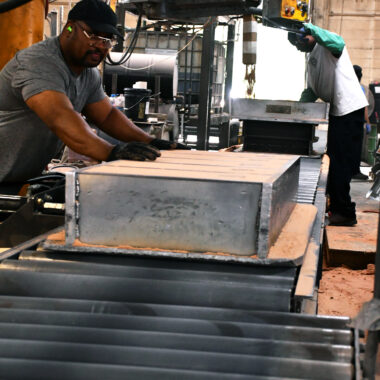Raise Your Assembly Line: Aluminum Casting Methods That Provide Results
Raise Your Assembly Line: Aluminum Casting Methods That Provide Results
Blog Article
Dive Into the World of Light Weight Aluminum Spreading: Comprehending the Different Approaches
Aluminum casting is a basic process in the production industry, with different methods utilized to create precise and elaborate elements. From the typical sand spreading method to the sophisticated die spreading process, each technique supplies special advantages depending on the demands of the task.
Sand Spreading Method
Sand casting, a widely-used method in light weight aluminum spreading processes, involves creating mold and mildews made of compressed sand for pouring molten metal. As soon as the mold and mildew is prepared, it is safely positioned in a flask and molten light weight aluminum is put into the cavity.
After the metal has actually cooled down and solidified, the sand mold is escaped to disclose the light weight aluminum casting. Sand casting permits for the manufacturing of complicated shapes and huge parts that may be challenging or expensive to create making use of various other techniques. It is likewise a sustainable strategy as the sand can be recycled and used multiple times, lowering waste in the spreading process.
Irreversible Mold Method

One significant advantage of the Long-term Mold Method is the enhanced dimensional accuracy it offers. The metal mold enables tighter tolerances and better information in the last light weight aluminum spreadings contrasted to sand spreading techniques. This precision makes it a preferred option for applications where tight dimensional control is vital, such as in the aerospace and vehicle markets.

Pass Away Casting Process

Investment Casting Method
Making use of a precision casting approach, Financial investment Casting Strategy includes creating detailed light weight aluminum components by pouring molten steel into a ceramic mold. This procedure, also recognized as lost-wax casting, starts with the development of a wax pattern of the desired component (aluminum casting).
The next action includes putting the liquified aluminum right into the ceramic mold. The aluminum fills up the cavity left by the wax pattern, taking its form precisely. This approach is favored for its capacity to produce intricate shapes with high precision and a smooth surface area finish. Financial investment casting is generally utilized for making parts in markets where limited resistances and detailed styles are called for, such as aerospace, automobile, and clinical equipment. The adaptability and accuracy of the Investment Casting Strategy make it an important strategy on the planet of aluminum spreading.
Lost Foam Casting Approach
Having actually discovered the detailed accuracy of Financial investment Casting Technique, the focus currently changes to try here the ingenious technique of Lost Foam Casting in light weight aluminum part production. Lost Foam Casting, also recognized as evaporative pattern spreading, is a contemporary method where a foam pattern of the desired part is produced and then covered with a refractory product.
One of the main benefits of Lost Foam Spreading is its capacity to create complicated forms with intricate details, frequently in a single piece without the demand for added machining. This approach is also understood for its high dimensional precision and smooth surface area coating. Additionally, Lost Foam Casting is an economical procedure as it reduces the need for cores and permits the manufacturing of lightweight parts. Regardless of its advantages, find out here Lost Foam Spreading needs mindful control of the casting procedure to ensure and prevent problems high quality components.
Final Thought
In conclusion, light weight aluminum casting supplies a range of approaches such as sand spreading, permanent mold technique, die spreading, investment spreading, and lost foam casting. Each approach has its own benefits and applications, making light weight aluminum casting a versatile and extensively utilized procedure in various sectors. Recognizing the differences between these approaches is essential in choosing one of the most ideal casting method for certain manufacturing needs.
Sand spreading, a widely-used method in find more aluminum casting processes, entails developing molds made of compacted sand for pouring molten metal. aluminum casting.The Long-term Mold Method, like sand casting, is one more common technique utilized in aluminum casting processes, supplying distinct advantages in terms of mold reusability and dimensional precision. The steel mold and mildew permits for tighter tolerances and better information in the last light weight aluminum spreadings contrasted to sand casting approaches. The two primary types of die casting are cold chamber die spreading and hot chamber die spreading, each ideal for various types of aluminum alloys.In verdict, light weight aluminum spreading uses a range of methods such as sand casting, irreversible mold technique, pass away spreading, investment casting, and shed foam casting
Report this page